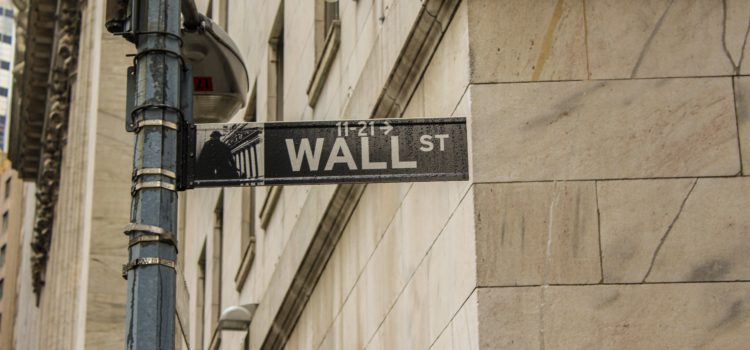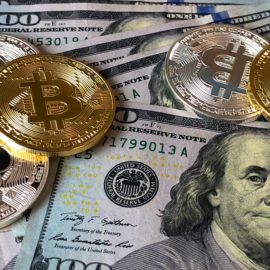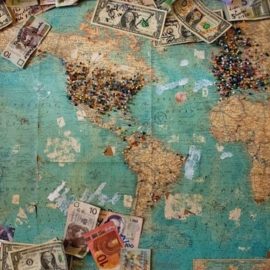

This article is an excerpt from the Shortform summary of "The Smartest Guys in the Room" by Bethany McLean and Peter Elkind. Shortform has the world's best summaries of books you should be reading.
Like this article? Sign up for a free trial here .
What contributed to the rise and fall of Enron, and why did the company collapse?
The rise and fall of Enron is marked by deceit, business failures, and unethical practices—all while Enron remained a shining star on the stock market and with investors. To understand the Rise and Fall of Enron, you have to consider market conditions as well as the company’s bad practices.
Enron Builds a Futures Market
The rise and fall of Enron starts with its founding and leadership changes.
1987, Jeff Skilling, a McKinsey consultant who worked with Enron, envisioned Enron building a futures market, turning natural gas into a commodity (then a novel concept).
Put simplistically, Enron would be the mediator between gas producers and gas buyers, with Enron earning the spread.
Enron was able to loan gas producers more money than banks, because it knew the clearing price of the gas. So producers signed contracts to supply gas to Enron, in exchange for upfront money to develop reserves. Enron could then trade the future contracts, just like oil futures.
Enron’s physical assets, ability to actually deliver gas, and its history and reputation gave it an edge over Wall St competitors who later entered the industry.
Securitization of gas lifted capital and balance sheets as constraints on growth. Selling its loans allowed Enron to eliminate debt from balance sheets and get cash to grow further.
This later became Enron Capital and Trade Resources (ECT) and by 1996 it made $280 million in EBIT, more than 20% of Enron’s earnings.
Enron International
The Enron International arm began in Teesside in the UK, with a natural gas cogeneration plant built in 1991. This plan supplied both electricity and heat to the local area. This was a successful project, prompting energy companies to ravenously seek similar deals in developing economies.
Rebecca Mark headed Enron International. Fueled by a compensation scheme that rewarded closing deals and not actually building the businesses, Rebecca Mark globetrotted and closed deals in dozens of countries. She positioned Enron as the “solver of the unsolvable problem.” She was hungry to come up with projects bigger and better than Teesside.
By 1996, Enron International accounted for 15% of Enron’s earnings.
Wall Street Expectations
Enron promised Wall Street 15% growth a year. This obsession with meeting earnings targets powered the deception that was later to come.
In 1997, Enron made $105MM, a 82% drop from 1996.
- Gas trading had become more competitive. Banks were making loans, and buyers were loath to sign long-term origination deals.
- Some earlier deals had turned out unwise and missed projections, requiring writedowns.
In this environment, where Enron made aggressive promises to investors, but had shakey core operations, it couldn’t resist the temptation to conduct fraud to meet numbers. The rise and fall of Enron would reflect these metrics.
Enron’s Two Big (Failed) Bets
All the financial machinations around SPEs were meant as temporary measures while Enron bet big on its next two major businesses. Both of them, however, sustained massive losses, contributing to the rise and fall of Enron.
Enron Energy Services – Retail Utilities
Enron’s historical bread and butter was large wholesale contracts with commercial buyers. But it believed there was a coming wave of deregulation, where federal/state governments would release municipalities from local monopolies to allow the free market to drive prices down. Enron could then sell directly to businesses and homes.
Enron Broadband
In 1999, Internet stocks were overheated. Put “broadband” in your company somewhere, and the stock price would rise without tying to fundamentals.
- Skilling calculated that every $1 invested in broadband would pay back $20 in market capitalization.
Skilling promised such large returns that the division was strongly pressured to make deals happen. They burnt a lot of money ($500MM a year) trying to find a valuable business plan.
Enron International is In Trouble
Meanwhile, former head of Enron International Rebecca Mark was in deep trouble at water services company Azurix.
With typical Enron hubris, Rebecca Mark thought water was easy and the incumbents were ancient. They would come in, make large deals, and figure out the details later. They also anticipated privatization of water supply, and a coming water crisis.
Immediately they ran into competition with two global heavyweights who competed aggressively for contracts to service municipalities.
Now a public company, Rebecca Mark stressed the appearance of making big deals to buttress their stock value. In the few deals that Azurix won, they vastly overbid, largely out of desperation to signal momentum.
4 months after IPO, Azurix had fallen to $13 a share; on a pessimistic earnings call in November, it fell to $8.
By the end of 2000, Azurix had less than $100MM in operating profit, down from $232MM at its start. Its debt load had quadrupled to $2 billion. Enron announced it would acquire the public shares at $8.375 a share.
Concerns Mount
There started to be mounting external and internal concern about the reality of the losses. The rise and fall of Enron was about to lead to a complete collapse.
By spring 2000, the dotcom bull market was over. Analysts were now questioning business plans and looking for fundamental cashflow and revenue. Momentum investors were selling instead of buying.
- Stories ran about how energy companies used mark-to-market accounting, and no outsider knew the assumptions they used to book earnings.
- Short sellers were gaining credibility and wielding larger sticks. Investor Chanos was skeptical Enron’s broadband business could be doing so well when the rest of the industry was getting slaughtered.
More negative signs cast doubt on Enron:
- Unclear disclosures about dealings with a related party
- Lay and Skilling were selling shares
- Debt was climbing when Enron was supposed to be profitable
- No one could explain how Enron made money
- Redeployments/layoffs were happening at the broadband business.
- In April 2001, on an earnings call, Skilling famously called a skeptical short-seller an “asshole” for saying Enron was the only firm who couldn’t release a balance sheet or cashflow statement. Said a stunned analyst, “any CEO should be able to handle the hardest of questions from the most aggressive of shorts.”
In February 2001, an Enron accountant, Wanda Curry, saw that EES (the retail division) had over-optimistic valuations of deals and bad trades that, on inspection, actually put the division in the red by $500MM.
- Enron’s solution was to merge the trading losses with the wholesale traders’ profits, eking out a mild profit in total. However, Enron didn’t properly report the combination of the two.
In March 2001, this book’s author (Bethany McLean) published a landmark article, “Is Enron Overpriced”, which showed the public that professional analysts had no idea how Enron made money.
Enron’s Final Moments
These are the final moments of the collapse in the story of the rise and fall of Enron. The nightmare scenario is more or less what happened at the end of 2001. Over a series of months, Enron collapsed, one step after another.
- Internal rumors began circulating about issues at Enron.
- The SPE Raptor deals ran into trouble.
- On Oct 16 2001, Enron shared its third quarter report. They were sanguine as usual: “recurring Q3 earnings of $.03 per diluted share; reports nonrecurring charges of $1.01 billion…reaffirms recurring estimates.”
- On Oct 24, 2001, Enron was unable to roll its “commercial paper,” short-term loans used for day-to-day expenses. It had no operating cash.
- Through this turmoil, Arthur Andersen began realizing how bad their work with Enron would make them look.
- Once dancing to Enron’s tune, the bankers realized their new leverage over Enron and took advantage.
- Beyond its credit line, Enron needed an extra $2 billion in cash. Banks refused to let it borrow the loans unsecured like before – now it demanded the only collateral remaining – the pipeline systems – and exclusive business with Enron for the next 18 months.
In early November, a possible savior came in a possible merger with smaller energy company Dynegy.
Meanwhile, the SEC required that Enron disclose the Fastow partnerships and restate its earnings on Thursday November 8.
- Also, all three ratings agencies cut Enron to one notch above junk by Nov 5. Shares went below $10.
- On Wednesday, the stock dropped 25% on news that Enron was unable to line up $2 billion from private investors.
On Friday, Enron announced the merger with Dynegy. Shares rose 16% to $10.
On Tuesday, November 13, $2 billion arrived for Enron. They took a breath, but it wasn’t enough.
- Enron realized it was going to need to repay more than $9 billion by the end of 2002. It would need a lot more money.
- Enron’s trading partners continued demanding collateral. The number of transactions plummeted, and trading profits crashed.
- An SPE (Rawhide) was structured to unwind if its debt had been downgraded to one step above junk. It now had to repay $690 million in debt.
- In six days, Enron had burned through a billion dollars. Its stock fell to below $5.
On Dynegy’s side, the lack of transparent disclosure of possible problems and Ken Lay’s insistence on maintaining control of Enron crashed the deal. The banks weren’t coming up with more money that Enron needed.
On Wednesday November 28, the rating agencies cut Enron into junk territory.
- This triggered $3.9 billion in debt.
- Dynegy officially canceled the deal.
- Enron Online shut down. Shares dropped to $0.61
Banks moved to minimize their losses, asking for return of collateral. Enron didn’t have it.
On Sunday, December 2, Enron filed for bankruptcy.
The rise and fall of Enron was on the biggest business scandals of all time. A business that was supposedly thriving suddenly collapsed, and it’s deceit was revealed. In reality, the rise and fall of Enron was always marked by business failure, manipulated to look good.

———End of Preview———
Like what you just read? Read the rest of the world's best summary of Bethany McLean and Peter Elkind's "The Smartest Guys in the Room" at Shortform .
Here's what you'll find in our full The Smartest Guys in the Room summary :
- How Enron rose to become one of the world's most promising companies
- How Enron management's greed led it to start cutting corners
- The critical failures that crashed Enron's house of cards to the ground






